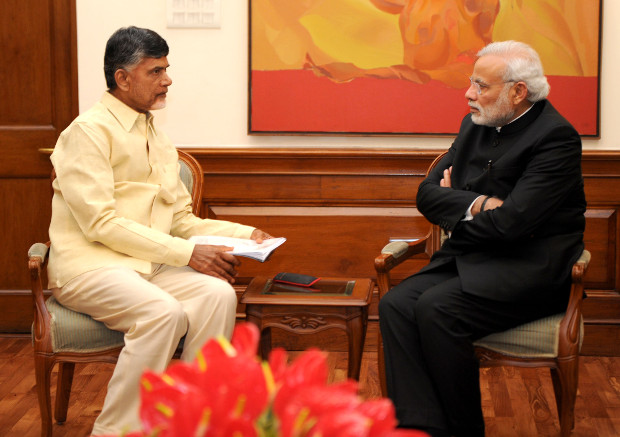Agricultural Income Rises, Andhra Plans Industrial Future

Chief minister of Andhra Pradesh, N. Chandra Babu Naidu (left) with Prime Minister Narendra Modi (right) in New Delhi on February 15, 2015.
Agriculture’s share in the gross domestic product (GDP) of truncated Andhra Pradesh is growing—unlike the decline India is witnessing—but the state plans an industrial future for itself.
Doubling per capita annual income of Rs 90,517 (in 2014-15) over four years and becoming home to India’s richest people—Andhra-ites are now 10th on the national income scale—by 2029. That’s the ambition laid out by finance minister Yanamala Ramakrishnudu in the second budget after AP’s reorganisation.
The share of agriculture in AP's GDP has increased from 22.96% to 27.59% in 2014-15, and the share of industries has reduced from 24.33% to 20.62%. The share of services has declined marginally from 52.72% to 51.79%, according to the finance minister.
Bifurcation of the state might have something to do with this anomaly. The new state of Telangana now has possession of Hyderabad, the primary economic engine of undivided AP. Before the split, agriculture’s share in GDP was 18%-19%; industry’s 23%-25% and services’ 55%-57%, according to planning commission data.
The industrial thrust includes a special industrial city for Japanese investors; special automomobile-manufacturing zones; a grand plan for 14 new ports and three international airports, and a 2-lakh-acre land bank for industries, new rail lines and highways.
At the core of the plans from Chief Minister Chandrababu Naidu is a new capital city, Amaravati. The budget has set aside Rs 3,168 crore over 2015-16 for its construction.
“The total land required is being secured by obtaining consent from the land owners of capital city consisting of about 33,252 acres,” said Ramakrishnudu. “Out of this land, 50% will be used for common infrastructure for the city which is required to build state-of-the-art infrastructure. About 25% will be returned to the land owners in the form of developed reconstituted plots. This leaves about 7,000 acres of land with the state for constructing its capital complex as well as bringing investments to provide sustainable jobs for the residents of the capital city.”
But states have realised their core constituencies and problems require special attention.
If Jammu and Kashmir had a separate power budget, AP has an agriculture budget. Naidu will also bear in mind that despite pleasing CEOs, rural dissatisfaction was instrumental in his election loss in 2004 .
With 84.58 million people — more than Egypt, Turkey or the UK — when last counted in 2011, AP has a mixed record on social indicators such as education, sex ratio and health:
The government has reduced expenditure on social services, from Rs 40,900 crore in 2013-14 to Rs 38,169 crore. The reduction has mainly been in housing (from Rs 2,083 crore to Rs 897 crore).
The finance minister said the total increase in the budget for 2015-16 is 1.1%; rising to Rs 1,13,048 crore from the budget estimate of Rs 1,11,823 crore for 2014-15.
“The increase in plan budget from Rs 26,672 crore to Rs 34,412 crore, an increase of 29.02% and increase in capital budget from Rs 7,069 crore to Rs 9,818 crore, up 38.88%, are significant achievements,” said Ramakrishnudu. “We have actually been able to bring down non-plan expenditure from Rs 85,151 crore to Rs 78,636 crore and non-plan revenue expenditure from Rs 78,976 crore to Rs 73,223 crore.”
While non-plan revenue expenditure refers to programme expenses, salaries and other spending, plan expenditure is for building assets.
The state’s outstanding debt is expected to increase to Rs 1.46 lakh crore ($23 billion) at the end of the financial year 2015-16. In comparison, Tamil Nadu’s debt is likely to cross Rs 2 lakh crore ($32 billion) and Maharashtra’s Rs 3 lakh crore ($48 billion).
Source: AP Budget
The state has moved from a revenue surplus of Rs 344 crore in 2013-14 to a deficit of Rs 14,242 crore in 2014-15. This is expected to be reduced by nearly 50% to Rs 7,300 crore in 2015-16.
Image credit: Press Information Bureau
_________________________________________________________________________
“Liked this story? Indiaspend.com is a non-profit, and we depend on readers like you to drive our public-interest journalism efforts. Donate Rs 500; Rs 1,000, Rs 2,000.”


